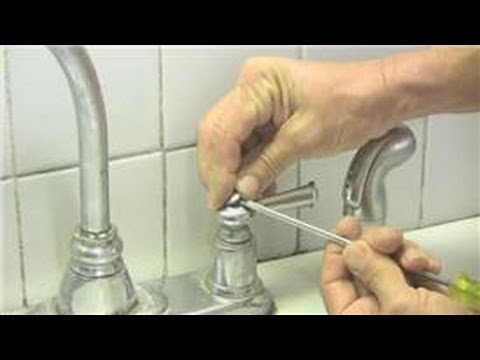A leaky kitchen faucet can be a frustrating problem. It wastes water and can lead to higher utility bills.
Understanding how to fix a leaky faucet with two handles can save you time and money. In this guide, you will learn the step-by-step process to repair your faucet. Many people think faucet repairs are complex, but they can be quite simple.
With the right tools and a little patience, you can tackle this task yourself. You’ll not only stop the leak but also gain confidence in your home repair skills. Let’s explore how to fix that pesky leak and restore your kitchen faucet to perfect working order.
:max_bytes(150000):strip_icc()/repair-a-two-handle-cartridge-faucet-1824887_07_complete_4919-d2621a771eff4c119902d1f90bb1caef.jpg)
Credit: www.thespruce.com
Common Causes Of Leaks
Leaky kitchen faucets often result from worn-out washers, loose connections, or damaged O-rings. Fixing a leaky two-handle faucet can be straightforward, requiring simple tools and a few replacement parts. Identifying the source of the leak is key to restoring your faucet’s functionality.
Understanding the common causes of leaks in a two-handle kitchen faucet is crucial for effective repairs. A leaky faucet not only wastes water but can also lead to bigger plumbing issues. Identifying the source of the leak is the first step in restoring your faucet to proper working condition.Worn-out Washers
Worn-out washers are often the primary culprits behind faucet leaks. As you use your faucet over time, these small rubber or plastic pieces can become brittle and cracked. When I first encountered a leak, I was surprised to find that replacing the washer was all it took to resolve the issue. To check if this is the problem, simply turn off the water supply and remove the faucet handle. Inspect the washer closely; if it looks damaged, replacing it can save you from constant dripping.Damaged O-rings
O-rings are another common source of leaks in two-handle faucets. These circular rubber gaskets create a seal between different parts of the faucet. If you notice water pooling around the base of the faucet handle, the O-ring may need replacement. Removing the handle will give you access to the O-ring for inspection. Finding a proper replacement is easy, and this simple fix can restore your faucet’s integrity in no time.Corroded Valve Seats
Corroded valve seats can also lead to leaks, often causing water to drip from the spout. The valve seat connects the faucet to the water supply, and corrosion can occur over time due to mineral buildup. I learned this the hard way when my faucet began leaking significantly, and I discovered that a little cleaning could have prevented the issue. To address this, remove the faucet stem and inspect the valve seat. If it looks rough or pitted, consider using a special seat wrench to smooth it out or replace it altogether. Addressing these common causes not only fixes the leak but also prolongs the life of your faucet. Have you encountered any of these issues before? What solutions worked for you?Tools And Materials Needed
To fix a leaky kitchen faucet with two handles, gather essential tools and materials. You will need a wrench, screwdrivers, replacement washers, and plumber’s tape. Having these items ready simplifies the repair process and ensures a smooth fix for your faucet.
When tackling the task of fixing a leaky kitchen faucet with two handles, having the right tools and materials is essential. Not only does this ensure a smoother repair process, but it can also save you time and frustration. Here’s a detailed overview of what you’ll need to get the job done efficiently.Basic Tools Checklist
Start by gathering these fundamental tools:- Adjustable wrench: This will help you loosen and tighten nuts and fittings.
- Screwdriver set: Both flathead and Phillips screwdrivers are essential.
- Plumber’s tape: Use this to prevent leaks on threaded connections.
- Bucket or container: Place this under the faucet to catch any water that may drip.
- Rags or towels: Handy for cleaning up spills and keeping your workspace tidy.
Replacement Parts
You’ll also need some replacement parts to ensure a successful fix:- O-rings: These small rubber rings are crucial for sealing connections.
- Washers: They help prevent leaks at the faucet handle and spout.
- Cartridge: If your faucet uses a cartridge system, replacing this can often solve leaks.
Safety Gear
Don’t overlook safety while you work! Here are some basic safety gear items to consider:- Gloves: Protect your hands from sharp edges and any cleaning chemicals.
- Safety goggles: Keep your eyes safe from any splashes or debris.
Preparing For The Repair
Fixing a leaky kitchen faucet with two handles is straightforward. Start by gathering the necessary tools and parts. Turn off the water supply, then carefully remove the handles to access the internal components. Replace worn-out washers and seals to stop the leak effectively.
Preparing for the repair of a leaky kitchen faucet with two handles can make all the difference in your DIY experience. Taking the time to set everything up properly ensures that your repair goes smoothly and efficiently. Follow these steps to get ready before you dive in.Turning Off The Water Supply
Before you start any repair, it’s crucial to turn off the water supply. Locate the shut-off valves under your sink. Turn them clockwise until they are fully closed. Don’t skip this step; it prevents a mini flood in your kitchen! If you can’t find the valves, you might need to turn off the main water supply for your home. Double-check that the water is off by turning on the faucet. If no water flows, you’re good to go.Clearing The Workspace
Next, clear your workspace. Remove any items from under the sink and around the faucet area. This not only gives you more room to work but also helps you avoid knocking things over accidentally. A clutter-free zone allows you to focus on the task at hand. Take a moment to inspect the area for any potential hazards like sharp objects or cleaning supplies that could get in the way.Gathering Tools Nearby
Gathering your tools is essential for a smooth repair process. Here’s a quick list of what you’ll need: – Adjustable wrench – Screwdriver (flat-head and Phillips) – Replacement washers or cartridges – Plumber’s grease – Towels to catch any drips Keep everything within arm’s reach. Having your tools close by saves you time and frustration. You won’t want to interrupt your flow by running around looking for that elusive wrench! Are you ready to tackle that leaky faucet? Taking these preparatory steps sets you up for success and helps you avoid unexpected hiccups along the way.
Credit: www.youtube.com
Removing The Faucet Handles
Removing the faucet handles is a crucial step in fixing a leaky kitchen faucet. This process requires careful attention to detail. Identifying the right techniques will make your task easier and faster. Let’s dive into how to do this effectively.
Locating Hidden Screws
First, look for hidden screws on the handles. These screws often hold the handles in place. They can be under decorative caps or tucked away from view. Use a flathead screwdriver to gently pry off any caps. This will reveal the screws underneath.
Check both handles carefully. Each handle may have its own screw. Inspect closely to avoid missing any hidden screws. Once found, you are ready to move to the next step.
Using The Right Tools
Gather the necessary tools before you start. You will need a screwdriver, an adjustable wrench, and possibly pliers. Make sure the screwdriver fits the screws properly. Using the wrong size can strip the screw, making removal difficult.
An adjustable wrench will help loosen any stubborn parts. Pliers can assist in gripping small components. Having the right tools will save time and effort.
Safely Detaching Handles
Once you locate the screws and gather your tools, it’s time to detach the handles. Start by unscrewing each handle gently. Turn the screwdriver counterclockwise until the screws are loose. Be careful not to apply too much force.
After removing the screws, pull the handles straight up. Avoid twisting or forcing them, as this can damage the faucet. Set the handles aside in a safe place to prevent losing them.
Replacing The Cartridge Or Stem
Fixing a leaky kitchen faucet often means replacing the cartridge or stem. This process can seem challenging. With the right steps, it becomes manageable. Follow these easy instructions to stop the leak.
Identifying The Correct Cartridge Type
First, turn off the water supply under the sink. Next, remove the faucet handles by unscrewing the screws. Look closely at the cartridge inside. Note its shape and size. Different faucets use different cartridges.
Bring the old cartridge to a hardware store. Compare it with new options. Make sure to choose the right type. This helps avoid further leaks.
Removing The Old Cartridge
After identifying the correct cartridge, it’s time to remove the old one. Use pliers or a wrench to grip the cartridge. Turn it counterclockwise gently. If it’s stuck, apply some lubricant. This can help loosen it.
Once loose, pull the cartridge straight out. Be careful not to damage the surrounding area. Check for any debris or old seals. Clean the inside of the faucet body before installing the new cartridge.
Installing The New Cartridge
Now, take the new cartridge and insert it into the faucet. Make sure it fits snugly. Turn it clockwise to secure it. Do not overtighten, as this can cause damage.
Replace the faucet handles and screws. Turn on the water supply. Test the faucet to ensure there are no leaks. Enjoy your drip-free kitchen faucet!
Replacing Washers And O-rings
Fixing a leaky kitchen faucet often means replacing washers and O-rings. These small parts wear out over time. They can lead to annoying drips. Understanding how to replace them is key to a successful repair.
Inspecting For Wear
Start by turning off the water supply. Then, remove the faucet handles carefully. Check the washers and O-rings for signs of wear. Look for cracks, fraying, or discoloration. Any damage means they need replacement. A worn washer can cause leaks. O-rings create a tight seal. If they are damaged, water will escape.
Choosing The Right Replacements
After inspecting, it’s time to select new parts. Take the old washers and O-rings to a hardware store. Compare sizes and materials. Choose the same size for a proper fit. Rubber is a common material for these parts. It is durable and water-resistant. Avoid using mismatched sizes. This can lead to further leaks.
Proper Installation Steps
To install new washers and O-rings, follow these steps. First, place the new O-ring on the faucet stem. Ensure it fits snugly. Next, insert the new washer into the handle. Make sure it sits flat. Reattach the faucet handle securely. Turn the water supply back on slowly. Test the faucet for leaks. Check under the sink as well.
Reassembling The Faucet
Fixing a leaky kitchen faucet with two handles is simple. Start by turning off the water supply. Remove the handles and replace worn washers or O-rings to stop the leak. Reassemble the faucet and turn the water back on to check for any leaks.
Reassembling the faucet is a crucial step in fixing a leaky kitchen faucet with two handles. It’s your chance to ensure that everything is put back together correctly, so you can enjoy a leak-free experience. Taking your time during this phase can save you from future headaches.Securing All Components
Start by placing all the components back into their designated spots. Ensure that the gaskets and O-rings are seated properly before you secure them. A little pressure can help keep everything in alignment. Use your hands to tighten the nuts gently, avoiding overtightening which could damage the parts. If you have a wrench, use it carefully to secure any larger components. Remember, a snug fit is what you’re aiming for.Reattaching Handles
Next, it’s time to reattach the handles. Align each handle with its corresponding shaft and press down firmly. You may need to wiggle them slightly to ensure they fit snugly. Once in place, secure the handles with the screws you removed earlier. A quick tip: if you have trouble keeping the handles aligned, ask a friend for an extra set of hands. This will make the process smoother and faster.Double-checking Tightness
After everything is in place, double-check the tightness of all screws and connections. This is a simple yet often overlooked step that can prevent leaks down the road. Turn on the water supply slowly and observe for any drips. If you notice any leaks, it’s wise to go back and check the tightened components. Taking these extra moments can save you from future repairs and ensure your faucet works perfectly. Have you ever faced leaks after a DIY project? Making sure everything is secure can make all the difference in your plumbing success.Testing And Finishing Up
Testing and finishing up involve checking your work after fixing a leaky kitchen faucet with two handles. Ensure all connections are tight and turn on the water slowly. Look for any leaks and make adjustments as needed for a secure fit.
After successfully replacing the worn-out parts of your leaky kitchen faucet, it’s time to test your handiwork. This stage is crucial to ensure everything is functioning properly and to avoid any surprises later. Follow these steps to finalize your repair and enjoy a leak-free faucet.Turning The Water Back On
Start by locating the water supply valves under your sink. Slowly turn them back on, ensuring you do it one at a time to keep track of any potential issues. Keep a close eye on your faucet as you do this. You might feel a rush of relief as water flows freely again. However, stay vigilant; unexpected leaks can occur at this stage.Checking For Leaks
Once the water is on, it’s time to check for leaks. Open both handles of the faucet and observe for any drips or water pooling around the base. If you notice water seeping out, you may need to tighten the fittings or ensure the parts are seated properly. Don’t skip this step! I once ignored a small leak, thinking it would fix itself. It only got worse, leading to a larger problem down the road. If everything looks good, congratulations! You’ve tackled the repair like a pro.Cleaning Up The Area
After confirming there are no leaks, it’s time to clean up your workspace. Wipe down the sink and surrounding areas to remove any water or debris from your repair. Check for any tools or parts left behind and put them away. A tidy space not only looks better but also prevents accidents. Taking these final steps ensures your kitchen remains functional and welcoming. What other repairs have you tackled in your home? Each one builds your confidence for the next!:max_bytes(150000):strip_icc()/repair-a-two-handle-cartridge-faucet-1824887_04_oldcartridge_4913-642676650a0e45a9af3253683eecf94d.jpg)
Credit: www.thespruce.com
Frequently Asked Questions
How Do You Stop A Two Handle Faucet From Dripping?
To stop a two-handle faucet from dripping, turn off the water supply. Remove the handles and access the cartridge or stem. Replace worn washers, O-rings, or cartridges. Reassemble the faucet and slowly turn on the supply valve. Run water briefly to clear debris.
What Is The Most Common Cause Of A Leaky Dripping Two Handle Faucet?
The most common cause of a leaky dripping two-handle faucet is a worn-out washer or gasket. Other possible causes include a loose O-ring or corrosion in the valve seat. These issues are often easy to diagnose and can be fixed with a standard faucet repair kit.
How To Remove Cartridge From Two Handle Faucet?
To remove a cartridge from a two-handle faucet, first, turn off the water supply. Next, open the faucet to drain any remaining water. Remove the handles by unscrewing any visible screws. Finally, pull out the cartridge straight from the faucet body.
How To Remove A Faucet Handle With No Visible Screws?
To remove a faucet handle with no visible screws, look for a decorative cap. Pry it off gently to reveal a screw. If there’s no screw, twist the handle counterclockwise to loosen it. Use a flathead screwdriver if needed to assist in loosening.
Conclusion
Fixing a leaky kitchen faucet with two handles is straightforward. You learned about the common causes and simple steps to repair it. Remember to gather the right tools before starting. Take your time and follow each step carefully. With a little effort, you can stop the drip and save water.
Regular maintenance can prevent future leaks. Enjoy your newly fixed faucet. A dry kitchen is a happy kitchen. Your efforts will make a difference. Thank you for reading!



